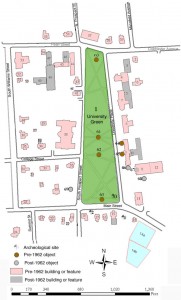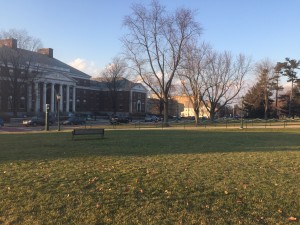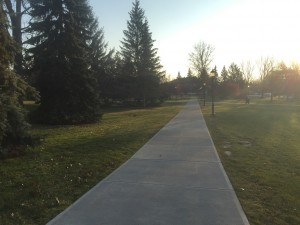Sitting in the middle of the University Green on a cold, windy day, it becomes clear that the beautiful expanse is in fact an amalgamation of the sounds which are most exemplary of the University of Vermont. Bike spokes whirring, students talking and laughing, food truck motors rumbling, and of course the noises from the construction site all make their way into the soundscape of the green. The strip of grass in the middle of the small city seems like an oasis, a place to get away from the sounds of traffic and the constant bustle of people. However, sounds from outside find their way in, and congregate at the Green, creating a place where all aspects of the University come together to create a singular soundscape that exemplifies the University and the City of Burlington.
As Feld states, sounds contribute to our meaning of humanity by contributing understanding, compassion, and identity to our lives. Schafer describes a keynote sound as “the anchor or fundamental tone” (Schafer: 100) of a soundscape, something that is always there but not always actively recognized. After listening to the University Green for some time, it becomes apparent that there are a few sounds which are constantly rumbling in the background, easily forgotten. From early each morning until around 4:00, food trucks line up along University Place and provide a soft undertone above which the rest of the sounds of the Green are heard. Although the trucks are not there at night, during the daylight hours they contribute to the soft drone created by the whoosh of ventilation from the surrounding buildings and the wind blowing across the open space.
Wherever you happen to be on the Green, it is always possible to hear the high-pitched, mechanical chirping of the crosswalk signals near Waterman Hall. These warning signs are clear signals in the soundscape, both managing interactions between humans and cars as well as the sounds they produce. Other than these signals, there is nothing to stop sounds from carrying all the way across the Green. The bells of the Ira Allen Chapel ring out across the space, managing our concept of time and making sure students make their way to class on time. These bells and chirps each provide context to the Green which would otherwise be an island to itself. We give these sounds meaning, using them as a way to tell time hour to hour, but also to know when it is safe to perform certain actions such as crossing the street. Since the rumble of traffic is fairly constant throughout the day (though it goes through waves of density), it is sometimes hard to hear the sounds given off by the Green itself. However, if you listen closely, it is possible to discern the quiet chirps of animals, and leaves skittering across the ground. For those who look (or listen) for it, the natural world of the Green presents itself in a soft-spoken fashion.
Sense of place is greatly shaped by the sounds of a location. Just as “part of the culture shock of India is its cacophony of sounds” (Coward: 1), the sounds of the University Green enculturate students into feeling more at home at the University of Vermont. Burlington is a city known for its healthy and happy people, a description which applies to the University of Vermont as well. Food trucks from local businesses can often be found across the small city, bringing joy to hungry students all around. The city is also known as biker-friendly, and the number of people who flock to the mountains each weekend is extremely high. As a result, bikes are a common sound to hear walking across campus or downtown. Additionally, the University Campus has recently been dominated by the construction of new first-year housing and a STEM building at its center. Sitting in the University Green, it is possible to hear all of these sounds come together in one place, which makes it a unique place through which we can listen to the heart of the University of Vermont. It makes sense that Commencement is held on the very same green where the sounds that define the city and University weave themselves together.
For our soundscape of the University Green, we decided to create a composition which conveys the nature of the Green as a collection of all things UVM. This involved overlaying sounds that did not originally occur in the same moment, just as Monacchi manipulated the sounds of the rainforest for his music. We did not change the tones of the sounds themselves, but instead rearranged and reimagined the true soundscape of the University Green into something that conveys the essence of the small oasis in the middle of the campus. We began with the simpler sounds of nature which are present on the Green: wind blowing through the trees, leaves skittering on the sidewalk, the occasional ramble of conversation. Next, more sounds begin to seep into consciousness, the droning rumble of motors rise in the background. Voices start to speak in the distance, as students pass between classes. Then BANG! Metal clangs together from the construction site nearby. This moment is the turning point of our soundscape, as it opens up the location to the world surrounding it. After the construction noises join the soundscape, the sounds of traffic and the machinery-centered world outside the green come in with a higher frequency, crescendoing into a cacophony of sounds from the University, all colliding at one moment. Finally, the sounds leave one by one, until only the restful whistle of wind through the trees is left. As John Cage states, “We want to capture and control these sounds, to use them… as musical instruments” (Cage: 3), and that is exactly what we have done in creating this soundscape. The final instrument of the wind in the trees shows the true heart of the University, since machinery sounds will always eventually end, always come second to the sounds of nature that pull students out towards the mountains to explore.
By Abra Clawson and Eryka Collins



